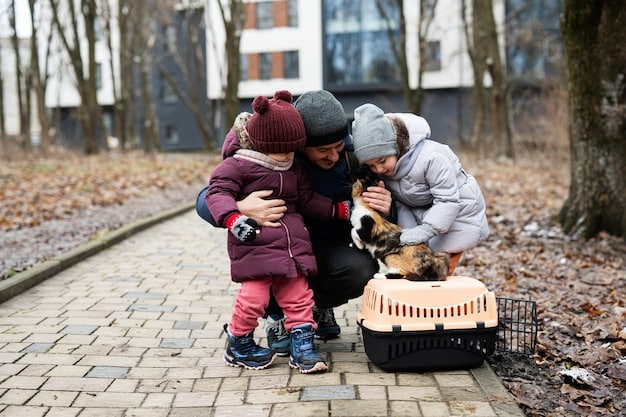Protecting Your Pets During Extreme Weather: A Comprehensive Guide

Protecting your pets during extreme weather involves preparing for and mitigating the specific risks posed by events like heat waves, cold snaps, storms, and wildfires, ensuring their safety and well-being through proactive measures and emergency planning.
Extreme weather events are becoming more frequent and intense, posing significant risks to our beloved pets. This comprehensive guide focuses on protecting your pets during extreme weather, providing essential strategies to ensure their safety and comfort.
Understanding the Risks of Extreme Weather for Pets
Extreme weather can affect pets differently than humans. Understanding these risks is the first step in protecting them from harm.
Heat Waves
Pets are particularly vulnerable to heatstroke because they have limited ability to sweat. Overheating can lead to severe health problems and even death.
Cold Snaps
Short-haired pets and small breeds are at a higher risk of hypothermia in cold weather. Prolonged exposure to cold can be life-threatening.
Wildfires and storms can cause stress, injury, or displacement for pets. Knowing how to protect them during these events is crucial.
- Provide plenty of fresh water during hot weather to prevent dehydration.
- Limit outdoor activities during the hottest part of the day.
- Never leave your pet in a parked car, even for a short time.
By understanding these risks, you can take proactive steps to protect your pets from extreme weather dangers.

Preparing Your Home for Extreme Weather
Preparing your home to withstand extreme weather is essential for the safety of your pets. Here’s what you need to do.
Creating a Safe Zone
Designate a safe and comfortable area in your home where your pets can retreat during extreme weather events.
Stocking Up on Supplies
Gather essential supplies such as food, water, medications, and first-aid items. Having these on hand can make a big difference during an emergency.
- Ensure your pet carrier is easily accessible for quick evacuations.
- Keep your pet’s identification and medical records in a waterproof container.
- Have extra blankets and bedding to keep your pets warm.
Preparing your home can greatly reduce the stress and risks associated with extreme weather for your pets.
Protecting Pets During Heat Waves
Heat waves can be especially dangerous for pets. Here are specific steps to keep them cool and safe.
Recognizing Signs of Heatstroke
Learn to recognize the symptoms of heatstroke, such as excessive panting, drooling, weakness, and vomiting. Early detection can save your pet’s life.
Keeping Pets Cool
Provide shade, water, and cooling aids to help your pets stay comfortable during hot weather.
Remember that prevention is key. By taking these precautions, you can help your pets stay safe and comfortable during the hottest days.
- Offer water frequently and consider adding ice cubes.
- Provide shade by using umbrellas or bringing your pet indoors.
- Use cooling mats or wet towels to help lower their body temperature.
Keeping Pets Warm During Cold Snaps
Protecting pets from the cold is just as important as shielding them from the heat. Here’s how to keep them warm during cold snaps.
Providing Warm Shelter
Ensure your pets have access to a warm and draft-free shelter. If they spend time outdoors, provide an insulated doghouse or cat shelter.
Using Pet-Safe Heating
Use pet-safe heating pads or blankets to provide extra warmth. Be cautious with space heaters, as they can pose a burn risk.
By taking these steps, you can help your pets stay safe and warm during cold weather.
- Dress your pet in a sweater or coat for added insulation.
- Bring outdoor pets indoors during extreme cold.
- Provide extra bedding to keep them warm at night.

Emergency Preparedness for Storms and Wildfires
Storms and wildfires require special emergency preparedness measures. Here’s what you need to know.
Creating an Evacuation Plan
Develop a detailed evacuation plan that includes your pets. Identify pet-friendly shelters or hotels in case you need to leave your home.
Protecting Pets from Wildfire Smoke
Keep your pets indoors during wildfires to protect them from smoke inhalation. Close windows and run air purifiers to improve air quality.
Being prepared can save your pets’ lives during these dangerous events.
- Keep a pet emergency kit with food, water, medications, and a leash.
- Ensure your pet has proper identification, such as a microchip or collar tag.
- Practice evacuation drills with your pets to reduce stress during an emergency.
Post-Weather Care for Pets
After an extreme weather event, it’s important to provide proper care for your pets to ensure their well-being.
Checking for Injuries
Carefully inspect your pets for any injuries or signs of illness. Seek veterinary care immediately if you notice anything concerning.
Providing Comfort and Reassurance
Extreme weather can be stressful for pets. Provide them with extra comfort and reassurance to help them recover.
Your pets will appreciate the extra attention and care.
- Create a calm environment by speaking in a soothing voice.
- Offer their favorite toys and treats to help them feel secure.
- Monitor their behavior for signs of stress or anxiety.
| Key Point | Brief Description |
|---|---|
| 🔥 Heatstroke | Recognize signs like panting, drooling, and weakness. Provide water and shade. |
| 🥶 Cold Shelter | Ensure warm, draft-free shelter. Use pet-safe heaters and blankets. |
| ⚠️ Evacuation Plan | Plan for pet-friendly shelters and emergency kits with essentials. |
| 💨 Smoke Protection | Keep pets indoors during wildfires. Use air purifiers to manage smoke. |
Frequently Asked Questions
▼
Signs of overheating include excessive panting, drooling, weakness, rapid heart rate, and vomiting. If you notice these symptoms, move your pet to a cool place and seek veterinary help immediately.
▼
A pet emergency kit should include food, water, medications, a first-aid kit, a leash, bowls, and copies of your pet’s medical records. A photo of your pet can also be helpful if they get lost.
▼
Create a safe and comfortable space for your pet, such as a crate or quiet room. Play calming music, offer distractions like toys, and consider using a pheromone diffuser to reduce anxiety.
▼
While space heaters can provide warmth, they pose a burn risk. Use them with caution and never leave your pet unattended near a space heater. Pet-safe heating pads or blankets are safer alternatives.
▼
Check on your outdoor pet frequently, especially during extreme weather. Provide fresh water, adequate shelter, and monitor their condition for signs of distress or discomfort. Consider bringing them indoors during severe events.
Conclusion
Taking proactive steps to protect your pets during extreme weather is crucial for their safety and well-being. By understanding the risks, preparing your home, and implementing appropriate measures, you can ensure your beloved companions stay safe and comfortable, no matter the weather.





